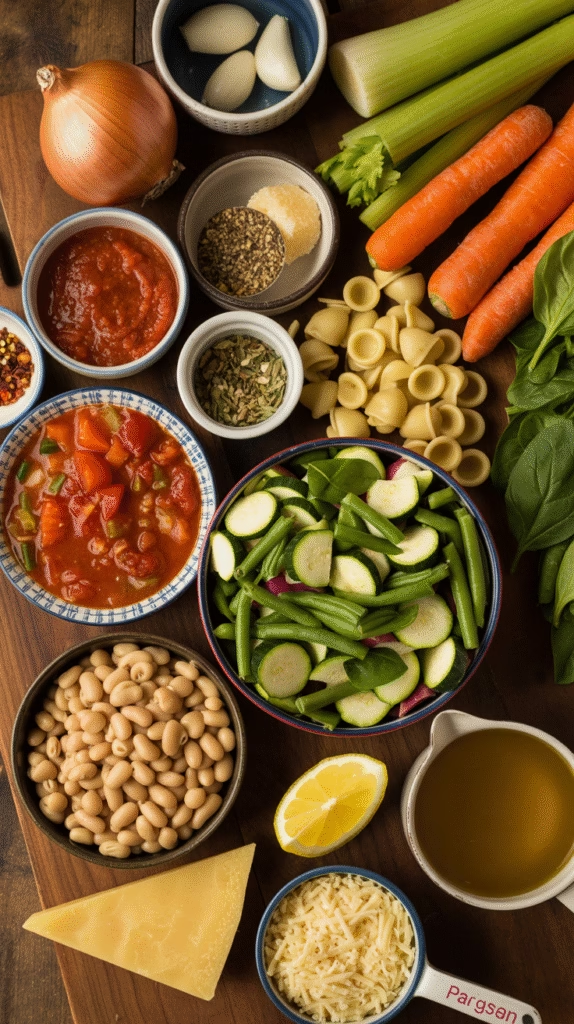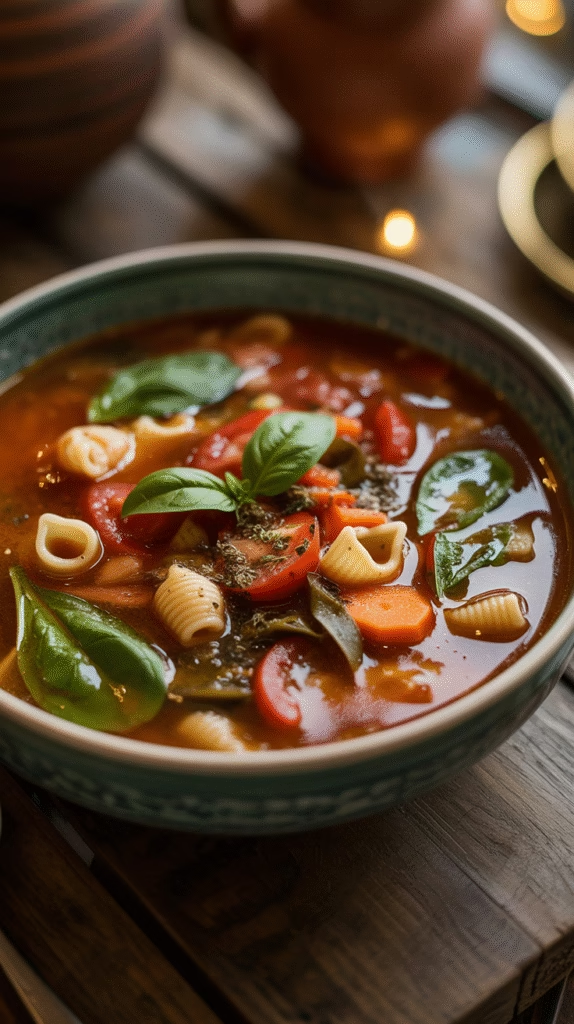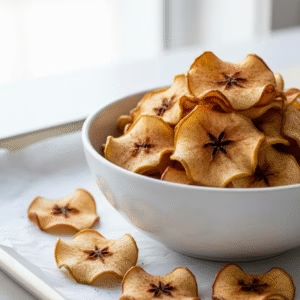Fun fact: Minestrone has been around since ancient Rome as a peasant dish consisting of seasonal ingredients, but it is now enjoyed globally for its deep flavors and nutritious qualities. Join us to learn how to make an authentic minestrone soup recipe and how you can customize the classic to your taste. Let’s cook!

Ingredients for Authentic Minestrone Soup
The beauty of minestrone lies in its flexibility, but an authentic version typically includes these key components:
Fresh Vegetables
The foundation of any good minestrone is a colorful array of vegetables. Traditional choices include:
- Carrots, celery, and onions (the Italian “soffritto” or flavor base)
- Zucchini or summer squash
- Fresh or canned tomatoes
- Leafy greens like spinach, kale, or Swiss chard
- Potatoes or sweet potatoes (in some regions)
- Green beans or peas when in season
Beans
Beans provide protein and create the soup’s signature hearty texture. Common choices include:
- Cannellini beans (white kidney beans)
- Borlotti beans (cranberry beans)
- Regular kidney beans
- Chickpeas (in some southern variations)
While dried beans provide exceptional flavor and texture when soaked overnight and cooked from scratch, high-quality canned beans are perfectly acceptable for a quicker preparation. If using canned, be sure to rinse them thoroughly to remove excess sodium and starch.
Pasta
Small pasta shapes complement minestrone without overwhelming it:
- Ditalini (tiny tubes)
- Elbow macaroni
- Orzo (rice-shaped pasta)
- Small shells
- Broken spaghetti pieces
In northern Italian versions, rice sometimes replaces pasta, particularly Arborio or other short-grain varieties.
Herbs & Seasonings
The aromatic foundation includes:
- Fresh or dried basil
- Bay leaves
- Fresh garlic
- Fresh parsley
- A Parmigiano-Reggiano rind (an Italian chef’s secret for incredible depth)
- Salt and freshly ground black pepper
- A dash of good quality olive oil to finish
Broth
The liquid component ties everything together:
- Vegetable broth for a traditional version
- Chicken broth for added richness (though less traditional)
- Water with tomato paste for a lighter base
Many Italian home cooks simply use water with a good soffritto base, allowing the vegetables themselves to create a flavorful broth as they simmer.

Step-by-Step Classic Minestrone Soup Recipe
Ingredients
- 2 tablespoons extra virgin olive oil, plus more for serving
- 1 large onion, diced
- 2 medium carrots, diced
- 2 celery stalks, diced
- 3 cloves garlic, minced
- 1 medium zucchini, diced
- 1 cup green beans, trimmed and cut into 1-inch pieces
- 1 can (14.5 oz) diced tomatoes
- 1 Parmesan rind (optional but recommended)
- 6 cups vegetable broth
- 1 bay leaf
- 1 teaspoon dried oregano
- 1/2 teaspoon dried thyme
- 1 can (15 oz) cannellini beans, drained and rinsed
- 1 can (15 oz) kidney beans, drained and rinsed
- 1 cup small pasta (ditalini, elbow, or small shells)
- 2 cups fresh spinach or kale, roughly chopped
- 1/4 cup fresh basil, chopped
- Salt and freshly ground black pepper to taste
- Grated Parmesan cheese for serving
Instructions
- Prepare Your Mise en Place Before beginning, chop all vegetables and measure ingredients. This organization makes the cooking process smoother and more enjoyable.
- Create the Flavor Base Heat olive oil in a large Dutch oven or heavy-bottomed pot over medium heat. Add the onion, carrots, and celery (the soffritto). Cook for 5-7 minutes until the vegetables begin to soften but not brown. This slow cooking releases natural sweetness and creates the foundational flavor of your soup.
- Build the Flavor Layers Add minced garlic and cook for another minute until fragrant. Then add zucchini and green beans, cooking for 3 minutes until they begin to soften.
- Add Tomatoes and Aromatics Stir in the diced tomatoes with their juice, scraping any browned bits from the bottom of the pot. Add the Parmesan rind (if using), vegetable broth, bay leaf, oregano, and thyme. Season with salt and pepper.
- Simmer the Base Bring the mixture to a boil, then reduce heat to maintain a gentle simmer. Cover partially and cook for about 15 minutes, allowing the vegetables to begin softening and the flavors to meld.
- Add Beans Stir in the drained and rinsed cannellini and kidney beans. Continue simmering for another 10 minutes.
- Cook the Pasta Add the pasta to the simmering soup. Cook until the pasta is al dente according to package instructions (usually about 8-10 minutes). Stir occasionally to prevent sticking.
- Finish with Greens When the pasta is nearly done, add the chopped spinach or kale and fresh basil. Simmer just until the greens wilt, about 2 minutes.
- Rest Before Serving Remove the bay leaf and Parmesan rind. Take the soup off the heat and let it rest for 5-10 minutes. This crucial step allows flavors to marry and deepen.
- Serve with Flair Ladle the minestrone into bowls. Drizzle each serving with a touch of good quality olive oil and sprinkle with freshly grated Parmesan cheese.
Variations & Customizations
Minestrone’s beauty lies in its adaptability. Here are some delicious ways to make it your own:
Vegetarian & Vegan Minestrone
The recipe above is already vegetarian (except for the Parmesan). For a vegan version:
- Skip the Parmesan rind and grated cheese
- Add a tablespoon of nutritional yeast for umami flavor
- Finish with a drizzle of high-quality olive oil
Gluten-Free Version
- Use gluten-free pasta, or substitute with rice
- Alternatively, skip the pasta altogether and add more beans or diced potatoes
Seasonal Adaptations
Summer Minestrone:
- Use fresh tomatoes instead of canned
- Add yellow summer squash alongside zucchini
- Incorporate fresh corn kernels
- Finish with abundant fresh basil and a squeeze of lemon
Winter Minestrone:
- Add hearty greens like kale or cabbage
- Include root vegetables like turnips or parsnips
- Use rosemary or sage as your primary herb
- Consider adding a Parmesan crust for extra richness
Protein Boosts
- Sauté 2 ounces of diced pancetta or bacon with the soffritto
- Brown 8 ounces of Italian sausage, removed from casings, before adding vegetables
- Add a cup of cooked, shredded chicken when adding the beans
- Double the beans for a protein-rich vegetarian version
Tips for the Best Minestrone Soup
Pasta Perfect Timing
Cook the pasta directly in the soup, but be strategic about timing. Add it only when everything else is nearly done, as pasta continues absorbing liquid even after cooking. If making ahead, consider cooking pasta separately and adding it to individual servings to prevent it from becoming mushy.
The Magic of Parmesan Rind
Never throw away Parmesan rinds! Keep them in your freezer to add to soups like minestrone. As they simmer, they release an incredible depth of savory umami flavor that elevates the entire dish. Simply remove the softened rind before serving.
Batch Cooking & Storage
Minestrone improves with time as flavors meld, making it perfect for batch cooking:
- Store in the refrigerator for up to 5 days
- Freeze in individual portions for up to 3 months
- If freezing, slightly undercook the pasta and add fresh herbs after reheating
Bread Pairings
The perfect bread transforms minestrone into an unforgettable meal:
- Crusty Italian ciabatta for dipping
- Garlic-rubbed toasted sourdough
- Homemade focaccia with rosemary
- Warm, crunchy breadsticks on the side

Common Mistakes to Avoid
Rushing the Soffritto
The onion, carrot, and celery base needs time to properly caramelize and develop flavor. Don’t rush this step by using high heat—a slow, patient approach creates depth that defines exceptional minestrone.
Pasta Overload
Remember that pasta expands significantly as it cooks and continues absorbing liquid afterward. Use about half the amount you think you need to maintain the soup’s perfect balance.
Bland Broth Foundation
If using store-bought broth, choose low-sodium varieties so you can control seasoning. Better yet, make a simple homemade vegetable stock the day before for truly remarkable flavor.
Neglecting Final Seasoning
Always taste your minestrone before serving and adjust seasoning. Sometimes a pinch of salt, a grind of pepper, or a squeeze of lemon juice right at the end makes all the difference.
Final Thoughts
Italian cooking philosophy is all about taking simple, humble ingredients and turning them into something extraordinary with thoughtful preparation and respect for flavor: Minestrone soup is a perfect example of this approach. Its beauty is not in rules but rather in adapting to what is fresh, seasonal, and available. What starts as an easy way to use up garden vegetables turns into an ode to flavor, texture, and tradition; each spoonful reminds us that great meals do not need fancy ingredients or advanced techniques: they only need time, care, and attention.
Classic Minestrone Soup Recipe
Course: Main Course, SoupsCuisine: ItalianDifficulty: Easy6-8
servings15
minutes35
minutes220
kcal50
minutesClassic Minestrone Soup is a comforting Italian favorite packed with fresh vegetables, tender beans, and perfectly cooked pasta in a rich, flavorful broth. It’s a nutritious one-pot meal that’s perfect for chilly days and makes excellent leftovers. With its combination of seasonal vegetables, protein-rich beans, and aromatic herbs, this soup delivers authentic Italian flavors while being completely customizable to your taste preferences and available ingredients.
Ingredients
Vegetables
2 tablespoons olive oil
1 medium onion, diced (about 1 cup)
2 carrots, diced (about 1 cup)
2 celery stalks, diced (about 1 cup)
3 cloves garlic, minced
1 medium zucchini, diced (about 1 cup)
1 cup green beans, trimmed and cut into 1-inch pieces
2 cups fresh spinach, chopped (or 1 cup frozen, thawed)
- Pantry Items
1 can (14.5 oz) diced tomatoes, with juice
1 can (15 oz) kidney beans, drained and rinsed
1 can (15 oz) cannellini beans, drained and rinsed
6 cups vegetable broth (or chicken broth)
1 cup small pasta (ditalini, elbow, or small shells)
2 tablespoons tomato paste
1 teaspoon dried oregano1
1 teaspoon dried basil
1/2 teaspoon dried thyme
1 bay leaf
Salt and black pepper to taste
1/4 cup fresh parsley, chopped
Parmesan cheese for serving (optional)
Directions
- Heat the oil: In a large pot or Dutch oven, heat olive oil over medium heat.
- Sauté aromatics: Add diced onion, carrots, and celery. Cook for 5-7 minutes until vegetables begin to soften. Add minced garlic and cook for another 30 seconds until fragrant.
- Add tomato paste: Stir in tomato paste and cook for 1 minute to develop flavor.
- Add liquids and seasonings: Pour in diced tomatoes with juice, vegetable broth, oregano, basil, thyme, and bay leaf. Bring to a boil.
- Add vegetables: Add zucchini and green beans. Reduce heat to medium-low and simmer for 15 minutes.
- Add beans and pasta: Stir in kidney beans, cannellini beans, and pasta. Cook for 10-12 minutes or until pasta is tender.
- Finish the soup: Add chopped spinach and cook for 2-3 minutes until wilted. Remove bay leaf.
- Season and serve: Taste and adjust seasoning with salt and pepper. Stir in fresh parsley. Serve hot with grated Parmesan cheese if desired.
Notes
- Make-ahead tip: This soup tastes even better the next day! The flavors meld beautifully overnight.
Pasta tip: If making ahead, consider cooking pasta separately and adding it to individual bowls to prevent overcooking.
Vegetable substitutions: Feel free to use seasonal vegetables like cabbage, bell peppers, or potatoes.
Bean variations: Any combination of beans works – try chickpeas, navy beans, or black beans.
Storage: Refrigerate for up to 4 days or freeze for up to 3 months.



